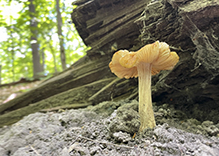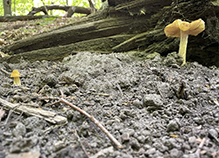Straight-stalked Entoloma
(Entoloma strictius)
Conservation • Description • Habitat • Ecology • Distribution • Taxonomy
Conservation Status |
|
|||||||
| IUCN Red List | not listed |
|||||||
| NatureServe | NNR - Unranked |
|||||||
| Minnesota | not listed |
|||||||
Description |
||
Straight-stalked Entoloma is a small to medium-sized gilled mushroom. It occurs in the United States and southern Canada east of the Great Plains and in the Pacific Northwest. It is found in summer and fall; alone, scattered, or in groups but not clustered (gregarious); in deciduous and mixed forests. It grows on the ground under oaks, beech, and other hardwoods, and possibly also under conifers. It has a mutually beneficial relationship (mycorrhizal) with the tiny rootlets of trees, absorbing sugars and amino acids while helping the tree absorb water. When it first appears, the cap is cone-shaped or convex and dark brown to grayish-brown or tan. The upper surface is smooth, moist but not sticky, and bald or covered with fine silky hairs. Mature caps are 1¼″ to 3½″ (3 to 9 cm) in diameter and broadly bell-shaped or flat, with a distinct but small raised bump in the middle (umbonate). The color is darker and more or less translucent when moist, becoming pale and opaque as it dries out (hygrophanous). The gills are closely or moderately spaced. They may be broadly attached (adnate), narrowly attached (adnexed), or not attached (free) to the stalk. They are white at first, becoming flushed with pink as the spores mature, and eventually brown on older specimens. The stalk is 2″ to 4″ (5 to 10 cm) long, ⅛″ to ⅜″ (4 to 10 mm) thick, often twisted, and colored like the cap or pale grayish-brown. It is equal in thickness from the top to the slightly enlarged base. It appears streaked due to longitudinal lines of fine, silky, hair-like fibers (fibrilose). The base is whitish due to a covering of threads (hyphae) of mycelium. The flesh is thin, fragile, and whitish to brownish. Edibility of this mushroom is unknown, but it should be avoided as it is similar in appearance to other little brown mushrooms (LBMs) that are known to be poisonous. The spore print is pink. |
||
Similar Species |
||
Habitat and Hosts |
||
Forests. Deciduous and possibly coniferous trees. |
||
Ecology |
||
Season |
||
Summer and fall |
||
Distribution |
||||
|
Sources |
|||
| 2/10/2023 | ||||
Occurrence |
||||
|
||||
Taxonomy |
|||
| Kingdom | Fungi (fungi) | ||
| Subkingdom | Dikarya | ||
| Phylum | Basidiomycota (club fungi) | ||
| Subphylum | Agaricomycotina (jelly fungi, yeasts, and mushrooms) | ||
| Class | Agaricomycetes (mushrooms, bracket fungi, puffballs, and allies) | ||
| Subclass | Agaricomycetidae | ||
| Order | Agaricales (common gilled mushrooms and allies) | ||
| Suborder | Tricholomatineae | ||
| Family | Entolomataceae | ||
| Genus | Entoloma (pinkgills) | ||
| Subgenus | Nolanea | ||
Section |
Holoconiota | ||
Synonyms |
|||
Agaricus strictior Nolanea strictior Rhodophyllus strictior |
|||
Common Names |
|||
Straight-stalked Entoloma |
|||
Glossary
Fibrillose
On mushrooms, covered with fine hair-like fibers.
Hygrophanous
Referring to mushroom tissue that is dark and more or less transparent when moist, becoming paler and opaque as it dries out.
Hypha
A thread-like cell of a fungus that is the main mode of vegetative growth: the basic structural unit of a multicellular fungus. Plural: hyphae. Collectively, the hyphae of a fungus is the mycelium.
Mycelium
The vegetative part of a fungus; consisting of a mass of branching, thread-like hyphae, through which a fungus absorbs nutrients from its environment; and excluding the fruiting, reproductive structure.
Mycorrhizal
A symbiotic, usually beneficial relationship between a fungus and the tiny rootlets of a plant, usually a tree.
Umbonate
On mushrooms, having a distinct, raised, knob-like projection in the center of the cap.
Visitor Photos |
|||||
Share your photo of this fungus. |
|||||
| This button not working for you? Simply email us at info@MinnesotaSeasons.com. Attach one or more photos and, if you like, a caption. |
|||||
Honey Fae (Farah) |
|||||
 |
 |
||||
MinnesotaSeasons.com Photos |
|||||
|
|||||

Visitor Videos |
|||
Share your video of this fungus. |
|||
| This button not working for you? Simply email us at info@MinnesotaSeasons.com. Attach a video, a YouTube link, or a cloud storage link. |
|||
Other Videos |
|||

Created: 2/10/2023
Last Updated:




